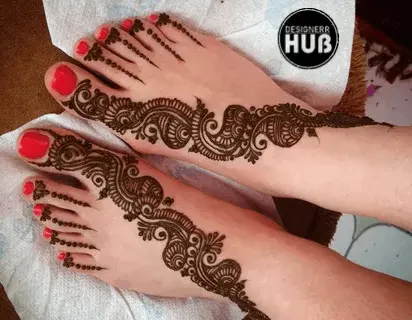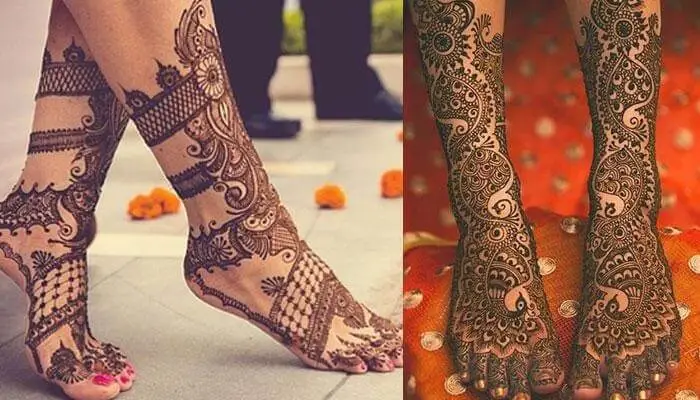Foot Mehndi Designs are colorful art forms done to the foot using a paste made from powdered henna plants. These designs often incorporate a variety of ornate and elaborate patterns, such as floral, geometric, and paisley themes.
Tattoos are a popular type of body art in many cultures in the world. They are frequently utilized for special events such as weddings and festivals. Many foot mehndi designs are influenced by traditional patterns from the Middle East and South Asia, but they may also incorporate innovative and modern features.

The designs may be created using either stencils or the typical cone or bottle applicator. It is perfect for people with little time or who are new to Mehndi because the designs are simple to produce and the application is simple and quick.
How Can We Easily Make Foot Mehndi Designs?
Here’s how to make a simple and beautiful mehndi design for legs:
- Start by cleaning and drying the legs to ensure that the mehndi applies evenly.
- Mix the mehndi paste according to instructions and put it in a cone or bottle for easy application.
- Draw a few basic shapes and patterns that we provide Below.
- Fill in the spaces with intricate details and shading, using fine lines to add depth and texture.
- Let the mehndi dry completely, usually for about 2-3 hours, before gently removing any residue with a damp cloth.
- To enhance the color, apply a mixture of lemon juice and sugar or eucalyptus oil to the mehndi design.
- Allow the design to set for at least 6 hours or overnight for the best results.
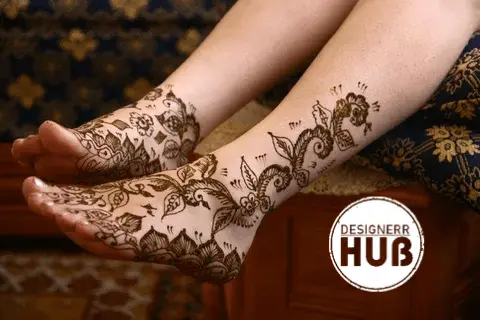
You Can Also Try: Leg Mehndi Design
Simple Leg Mehndi Designs are simple henna designs applied to the legs. Typically featuring clean lines and simple patterns, as well as geometric forms, floral motifs, and abstract designs. They may be applied to the entire leg or particular areas such as the ankle, calf, and thigh.
They can be applied using the conventional way using a cone or bottle applicator or stencils. These patterns are simple to develop, and the application is simple and quick, making them excellent for individuals with limited time or who are new to Mehndi.
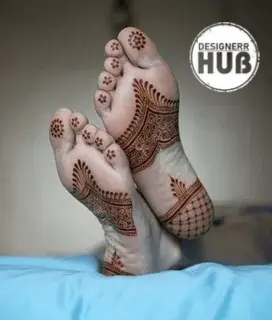
Arabic Feet Mehdi Design:
Arabic Mehndi Designs For Foot is a style of henna art that developed in the Arab area and is distinguished by its strong and detailed designs. With a heavy emphasis on symmetry and equilibrium, these patterns often contain vast, intricate floral and geometric motifs.
Arabic mehndi patterns on the foot can be applied using either the traditional cone or bottle applicator or stencils. They may also be worn by both men and women as a fashionable fashion statement.

Easy Mehndi Designs For Leg are simple henna patterns that are applied to the legs. These designs often contain clean lines and minimalistic patterns, as well as geometric forms, floral motifs, and abstract patterns.
Moreover, They can be applied using the conventional way using a cone or bottle applicator or stencils. They are simple to produce, and the application is simple and quick, making them great for individuals with little time or who are new to Mehndi.
Full Leg Mehndi Designs For Bride are decorative henna patterns applied on the legs. These patterns are often more intricate and complex than standard mehndi patterns, and they frequently combine traditional and contemporary features.
In addition to floral patterns, paisleys, geometric forms, and motifs, they may also feature traditional symbols. They are frequently used in Indian, Pakistani, and Arabic cultures as part of the bridal preparations for weddings and are seen as an essential component of the bride’s attractiveness and dress.
These patterns may be created using either stencils or the classic cone or bottle applicator. They might be basic or complex based on the bride’s desire. They may also be personalized to complement the bride’s ensemble and wedding theme.
You can Visit PINTEREST

Leg Mehndi Designs For Bride are artistic henna patterns that are put on the bride’s legs as part of her wedding preparations. These patterns are often more intricate and complex than standard mehndi patterns, and they frequently combine traditional and contemporary features.
They may have floral designs, paisleys, geometric forms and motifs, and traditional symbols as well. These patterns may be applied to the entire leg or to select areas, such as the ankle, calf, or thigh. In the Indian, Pakistani, and Arabic cultures, they are frequently utilized as a part of the bridal preparations for weddings and are seen as an integral aspect of the bride’s attractiveness and dress.
These patterns may be created using either stencils or the classic cone or bottle applicator. The patterns might be simple or intricate, depending on the bride’s desire.
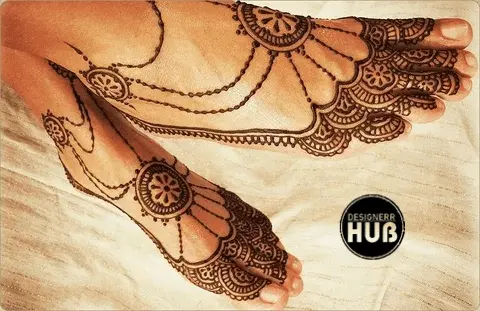
Leg Finger Mehndi Designs are henna patterns that are applied on both the legs and the fingers. This pattern is a blend of classic mehndi designs for the feet and hands. These patterns can range from simple and minimal to elaborate and ornate, and they frequently combine traditional and contemporary features.
They may have floral designs, paisleys, geometric forms and motifs, and traditional symbols as well. Depending on the choice of the wearer, they can be applied to all fingers and legs, or only to select portions. They are ideal for big events such as weddings, celebrations, and festivals, but may also be worn every day.
You can Visit Neck Designs.
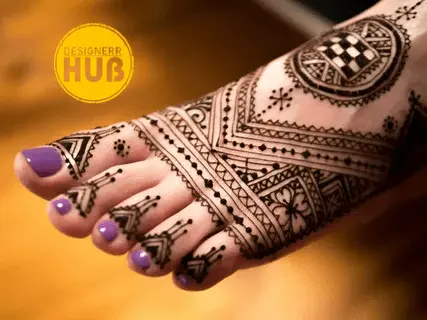
Foot Mehndi Designs For Karwa Chauth are decorative henna patterns put on the feet as part of the festival’s traditional preparations. Karwa Chauth is a holiday observed by Hindu women, mostly in northern India, during which they fast for the health, longevity, and wealth of their husbands.
Typically, these designs incorporate a variety of delicate and detailed patterns, such as floral, geometric, and paisley motifs, as well as traditional symbols linked with the Karwa Chauth celebration. They are typically worn to accentuate the beauty of the feet and lend a festive touch to the overall appearance of the woman celebrating the holiday.
These patterns may be created using either stencils or the classic cone or bottle applicator. They are simple to prepare and simple to apply, making them great for individuals who are pressed for time or who are new to Mehndi.
